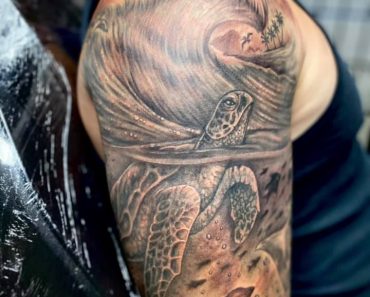When it comes to getting inked, each one us has its own charisma and it also has its individual set of critics. And especially when it comes to Yakuza tattoos, you will discover that there is no scarcity of souls with their own mighty theories on this. This is essentially because the Yakuza tattoos are symbolic of organized criminality in Japan.
Three out of all the days per year, on the third weekend of May, the alleys of Tokyo’s Asakusa region come swarming. A vast cavalcade of men, disrobed to their underclothes, engulf the roads and flaunt the weaving of colors onto their skin, gratitude to the antiquated Japanese tattoo artwork of ‘irezumi’. It is the Sanja Matsuri festival where these men exhibit the full-body tattoos that, in the cognizances of many, are the real thing that identify them as outlaws.
To the policemen patrolling from the sidelines, it can appear as an unnerving demonstration of power and intensity. A whole mob of people is present, applauding the criminals, actively showing off their irezumi — now generally thought of as a Yakuza tattoo custom. But an irezumi is not bounded to be just a Yakuza tattoo, it is the trace of a complicated Japanese tradition that has been a component of the nation’s antiquity for a remarkable 12,000 years.
It can’t be dismissed that this unconventional ritual has influenced a number of people around the world as many resolves to get alike tattoo patterns for themselves.
Below are the 25 most common Yakuza tattoo designs with their corresponding symbolism and context.
-
Koi Fish
The koi fish is a usual yakuza tattoo that ordinarily is associated with good fate and prosperity. In Japanese legends, it’s said that a koi can surmount waterfalls, moving against a heavy tide. Thus, koi exemplify resolution and are often used to mean that a person has made it through unfortunate events. All of this pertains to black koi.
The red koi denotes the love of some sort, typically strong, vigorous love, such as the congenial relations of yakuza fraternity. Blue koi are representatives of reproduction and are considered extremely masculine.
-
Dragon Tattoo
Dragons are observed in a different way in Japan than it is in the West. The Japanese see dragons as patrons and guardians of humankind. Dragon tattoos signify courage, enlightenment, and durability. Black dragons are compared with expertise and enlightenment. Green dragons are associated with nature, and gold dragons describe substance and a medley of virtues. Blue dragons are tender, humane, and altruistic, while yellow dragons are worthy partners.
In summation of emblematic colors, there are six dragon alternatives in Japanese culture. They are Sui, Han, Ri, Fuku, Ka, and Hai, which are oftentimes inscribed with the word “ryu” (“dragon”) at the end (for instance, Sui-ryu). Each of these variants has its own significance; Sui, for example, is the emperor of dragons, while Ri occupies exceptional foresight.
-
Phoenix
The phoenix is a mystical bird that, despite being consumed by fire, takes a rebirth from its own ashes. In order with the story of the phoenix, this tattoo symbolizes resurrection, victory, and ardor. It is a familiar motif in yakuza tattoos. The myth of the phoenix appeared in Japan through China, as did many other features of Japanese culture.
-
Snake Tattoo
The snake tattoo has a number of connotations in Japan. It is recognized as an epitome of regenerative power and a symbol of good health. In Japanese legends, snakes are connected with knowledge, divination, and the powers of the cosmos. They also symbolize spiritual female traits and can be symbolic of evading illness and bad luck. In the Chinese zodiac, those taking birth in the year of the snake are scholars and sophists, the intelligent lot with a headstrong streak.
-
Samurai Tattoos
Samurai tattoos denote the principles of Bushido, precisely, the ‘way’ (do) of ‘the warrior’ (bushi). The code emphasizes honor, bravery, integrity, and proper execution. It is deeply rooted in Buddhist and Confucian principles. Yakuza have embraced multiple opinions from Bushido, and acknowledge themselves as guardians of ancient Japanese tradition. However, a close reading of yakuza chronicle reveals that this is misleading. Early yakuza were the opponents of samurai or at least had very suspicious relationships with them. Nonetheless, when samurais were assimilated into mainstream society in the Edo and Meiji periods, some got associated with the yakuza, and got samurai tattoos as a mark of identification and legacy.
-
Cherry Blossom Designs
Cherry blossoms (“sakura”) are profoundly notable in the Japanese culture. Their evanescent nature and very short-lived lifespan signify life itself, which in classical Japanese dogma is little more than grass hovering in a swiftly swirling brook. Once sakura falls from the tree, they’re disseminated by breeze and rainfall and thence, vanish from the surface of the earth.
Each year, the Japanese hold hanami (flower viewing), a celebration of life during which fellows and folks have a little get together and get wasted while relishing the excellence of the spring sakura. In a way, sakura tattoos describe that although life is passing, but is still full of colors and beauty.
-
Oni Masks
Oni is ogres or fiends that dole out grisly penalties to the sinister. They are massive and terrifying, ordinarily painted with red or blue skin, unrestrained white hair, and fangs. They operate extensive, spiked clubs, can transform at will, cause disease, insanity, and death. Their ideal diet consists of human flesh. Thus, the oni mask tattoo exemplifies the execution of behavior principles and the doling out discipline. Oni is perceived to intimidate villages, breed social degeneration, and are recognized as reincarnations of particularly malicious people, which harmonizes with the yakuza lifestyle.
-
Fierce as Tiger
The tiger (“tora”) is engaged in Japanese tattoo culture to safeguard against devils, illnesses, and bad fate. In Japanese lores, the tiger depicts the fall season and can constrain the wind as one of four sacred, elements of the earth. It also embodies bravery and tenacity.
-
The Guardians of Buddha
Foo dogs, also known as the Lions of Buddha, are protectors of Buddhist stupas. If you’ve ever been to a Japanese temple, you would have surely observed figures of foo dogs, which appear in twos and are known as komainu. The beast is actually a lion and gets its name due to its correspondence to dogs. As a famous yakuza tattoo, the foo dog gives ultimate protection against all the perils and failures. Because foo dogs emerge in pairs, it’s not unusual for a person to get both of them inked.
-
Namakubi
The blood-soaked head tattoo, or namakubi, can symbolize fearlessness, strength, and, surprisingly, admiration for an opponent. It can also be acknowledged as a signal. Nothing states “don’t mess with me” like a severed head tattooed on your body. The leitmotif has traditional roots in the samurai custom of headhunting in battles.
-
Peony Flower
The peony flower, or botan, represents abundance, dignity, and accomplishment. Contrary to its corporal beauty and identification with feminine grace, the peony is prized as the King of Flowers in Japan, and as such, can typify a masculine and nonchalant attitude.
-
Yet Another Flower
In Japan, the chrysanthemum is a representation of the Imperial family. It is estimated to be the stellar flower with its petals scattering outwards like flames. The core of the flower depicts the emperor’s social rank in the midst of all things. The tattoo represents durability and satisfaction. In irezumi, flowers frequently surface with other subjects in the shape of large and elaborated tattoos. Chrysanthemums usually appear alongside dragons in such compositions.
-
Momiji or Maple
Maple leaves (“momiji”) are illustrative of the passage of time. These tattoos typically represent the leaves entangled in the breeze or drifting in the water, which describes people caught up in the flow of time. The sequence of life is also symbolized by the leaves altering with the seasons.
-
Lotus
The lotus is closely bound to the Buddhist doctrine. In Japan, the flower signifies the strains of life in the journey to reach its complete potential. The flower sprouts at the floor of a pond and gradually makes its way to the exterior in order to bloom. Thus, the blossoming lotus tattoo symbolizes spiritual revival and the metaphorical ride through the muck of life to a greater sphere of existence.
-
Elemental Water
Many Japanese tattoos comprise of elements of water. This denotes change, compliance, and survival. The island nation oftentimes highlights water in its artwork, and the sea is often used to describe the stalwart forces of nature.
-
Shark Fish Tattoo
Just like the koi fish, the shark is a water animal that has great significance. It is representative of valor, strength, and passion.
-
Skull Tattoo
The illustration of the mortal skull in the majority of tattoo culture– and art, in general, have morose intentions associated with it (such as destruction, crisis, and ill fortune). However, the skull engaged in Japanese tattoos is meant to be a positive depiction of the natural life cycle. Traditionally, the Japanese skull tattoo expresses development, which is insightful as death is the greatest advancement a man can undergo.
-
Hannya Mask
Intimately linked with the Oni mask design is the Hannya mask. Both Oni and Hannya are incubi, but, the Hannya mask is representative of a female brute.
-
Samurai and Koi
This tattoo is an amalgamation of the samurai and the koi fish representing strength and fortune.
-
Couple Samurai
Samurai are the high-class and well-disciplined combatants in Japan whose purpose is to guard their people, their culture and territory. They are thoroughly trained in martial art. They are extreme human beings with essential combat abilities.
The repercussions against the ink in Japan aren’t just against Yakuza members, although it is partly to keep Yakuza members out of vocations and government establishments. This is implemented for all workers and not just members of the Yakuza. One of the purposes of the crackdown is to keep Yakuza members out of positions of authority within the city government. While the Yakuza has an eminence for being very mythical and dim, the stunningly attractive Yakuza tattoo vogues are being mimicked by ink practitioners all over the world.






























